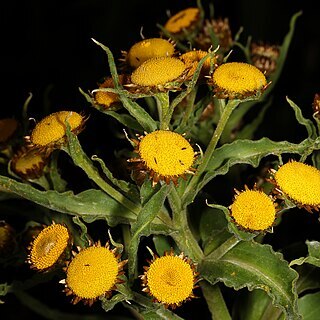Perennial herb, up to 1 m high; strongly aromatic, with slender rhizome; flowering stems simple, glandular-pubescent, leafy throughout. Leaves in a basal rosette, withered at flowering; blade of basal leaves narrowly obovate, up to 350 x 55 mm, apex subacute or obtuse, narrowed to broad, petiole-like base, clasping; both surfaces thinly grey-woolly; blade of stem leaves elliptic-obovate, up to ± 120 x 30 mm, smaller upwards, apex acute to acuminate, base cordate-clasping, shortly decurrent, both surfaces minutely glandular-pubescent. Heads disciform, depressed-globose, ± 7-8 x ± 15-18 mm, many in a large, spreading, leafy, corymbose panicle. Involucral bracts in 6 series, graded, imbricate, exceeding florets, radiating, glossy light brown, very acute, stereome divided. Receptacle epaleate, honeycombed. Flowers: female and disc florets 423-1.26-97 female; corolla of disc florets cylindric, orange-yellow; Oct.-Dec., Mar., May. Fruit with cypsela (and ovary) glabrous. Pappus of many barbellate bristles, bases with patent cilia, lightly cohering or not.
Strongly aromatic, flowering stem up to 1 m high, simple, glandular-pubescent, leafy throughout. Leaves: radical leaves rosetted, withered at flowering, up to 350 mm long, oblanceolate, petiole-like base clasping; cauline leaves up to ± 120 mm long, smaller upwards, elliptic-lanceolate, base cordate-clasping, shortly decurrent. Capitula depressed-globose, ± 7-8 mm long, many in a large, spreading, leafy, corymbose panicle; involucral bracts in 6 series, graded, glossy light brown, very acute. Flowers 423-731, orange-yellow. Flowering time Oct.-Jan. Pappus of many bristles, bases with patent cilia, ± cohering. Cypselae 0.75 mm long, barrel-shaped.

